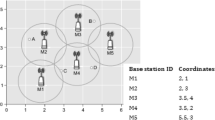Abstract
In this paper, a dynamic resource allocation scheme for a wireless local area network system is presented. It aims at enforcing the Quality of Service requirements of the applications that are carried on the wireless link even when errors occur on it. The allocation takes benefit from the coexistence of connections that have different QoS tolerances so that, when facing errors, the bandwidth allocated to the more tolerant connections could be reduced and attributed to the connection with more stringent QoS requirements to perform retransmissions. For that purpose, two classes of Quality of Service are considered that are related to Constant Bit Rate traffics and best-effort traffics. The scheduling framework is then based on a hierarchical rate-based fair queuing algorithm and is extended in order to cope with error. To illustrate its operation, the proposed scheme is applied to the ETSI HiperLAN/2 WLAN. Some simulation results are reported and show the impact of the scheduling principles on best-effort traffics such as TCP applications and its actual benefits for CBR traffic. The efficiency of the proposed mechanism is evaluated using measurement of delays and throughputs at Data Link Layer level. The aim of this paper is not so much to prove the fairness of this mechanism but rather its ability to guarantee negotiated services required by heterogeneous applications.
Similar content being viewed by others
References
H. Balakrishnan, V.N. Padmanabhan, S. Seshan and R.H. Katz, A comparison of mechanisms for improving TCP performance over wireless links, IEEE/ACM Transactions on Networking 5(6) (1997) 56–769.
P. Boyer, F. Guillemin, M. Servel and J.-P. Coudreuse, Spacing cells protects and enhances utilisation of ATM network links, IEEE Network Magazine 6(5) (1992) 38–49.
A. Chandra, V. Gummalla and J.O. Limb, Wireless medium access control protocols, in: IEEE Communications Surveys and Tutorials, http://www.comsoc.org/pubs/surveys, Second Quarter 2000.
D.A. Eckhardt and P. Steenkiste, Effort-limited fair scheduling (ELF) for wireless networks, in: Proc. of IEEE INFOCOM 2000 (March 2000).
T.S. Eugene Ng, I. Stoica and H. Zhang, Packet fair queueing algorithms for wireless networks with location-dependent errors, in: Proc. of IEEE INFOCOM ‘98 (March 1998).
H. Fattah and C. Leung, An overview of scheduling algorithms in wireless multimedia networks, IEEE Wireless Communications (October 2002).
S.J. Golestani, A self-clocked fair queueing scheme for broadband applications, in: Proc. of IEEE INFOCOM ‘94 (June 1994) vol. 2, pp. 636–646.
H. Li, J. Lindskog, G. Malmgren, G. Myklós, F. Nilsson and G. Rydnell, Atomatic repeat request (ARQ) mechanism in HiperLAN/2, in: Proc. of IEEE VTC 2000 Spring (May 2000).
S. Lu, T. Nandagopal and V. Bharghavan, A wireless fair service algorithm for packet cellular networks, in: Proc. of ACM MOBICOM ‘98 (October 1998).
G. Myklós and S. Molnár, Fair allocation of elastic traffic for a wireless base station, in: Proc. of IEEE GLOBECOM ‘99 (December 1999).
T. Nadndagopal, S. Lu and V. Bharghavan, A unified architecture for the design and evaluation of wireless fair queuing algorithms, Wireless Networks 8 (2002) 231–247.
P. Ramanathan and P. Agrawal, Adapting packet fair queueing to wireless networks, in: Proc. of ACM MOBICOM ‘98 (October 1998).
J. Roberts, Virtual spacing for flexible traffic control, Int’l Journal of Communication Systems 7 (1994) 307–318.
R. Rollet, C. Rosier, H. Bonneville and C. Mangin, Field trial results at DLC layer of a HiperLAN/2 prototype, VTC Spring (April 2003).
TS 101 761–1 Ver. 1.3.1C, Broadband Radio Access Networks (BRAN); HIPERLAN type 2; data link control (DLC) Layer; Part 1: Basic data transport functions, ETSI, October 2001.
H. Zhang and S. Keshav, Comparison of rate-based service disciplines, in: Proc. of ACM SIGCOMM ‘91, (September 1991) pp. 113–121.
Author information
Authors and Affiliations
Corresponding author
Additional information
Christophe Mangin is a research engineer at Mitsubishi Electric ITE-TCL. He received degrees in Electrical Engineering from Institut National des Sciences Appliquées (INSA), Rennes, France, in 1988, and in VLSI architecture from Université Paris VI, in 1989. From 1989 to 1991, he was with ALCATEL SEL, Stuttgart, Germany, where he was involved in parallel DSP design for image processing. From 1991 to 1999, he worked at France Telecom R&D, Lannion, France, in the field of packet switch/router architectures, ATM resource management techniques, and Internet network architecture. In 1999, he joined Mitsubishi Electric ITE’s Telecommunication Laboratory, Rennes, France. His present research interests include broadband wireless systems and wireless-wired network interoperability with a special focus on quality of service mechanisms for Internet applications in heterogeneous networks.
Gwillerm Froc received the PhD degree in Physics in 1997 from the University of Paris XI. At that time, his research interests were related to the optical telecommunications field. Then, he worked at France Telecom R&D on reliable multicast protocols on IP for satellite broadcasting. He joined Mitsubishi Electric ITE in 2001. His main scientific and engineering interests now deal with performances and modelling of wireless systems. They currently focus on MAC protocols.
Romain Rollet received his M.Sc. in electronics and computer engineering from the Ecole Supérieur d’Electricité (Supelec), France in 1998. In 2000, he joined Mitsubishi Electric Telecom Laboratory in Rennes where he has participated to the development and implementation of a complete HiperLAN/2 prototype. His current research areas are mostly related to Data Link layer and interactions between physical and MAC layers in future WLAN systems. He is the author or co-author of several pending patents.
Rights and permissions
About this article
Cite this article
Mangin, C., Froc, G. & Rollet, R. Resource Allocation and Wireless Scheduling Scheme for a HiperLAN/2 System. Mobile Netw Appl 10, 639–650 (2005). https://doi.org/10.1007/s11036-005-3359-6
Issue Date:
DOI: https://doi.org/10.1007/s11036-005-3359-6




